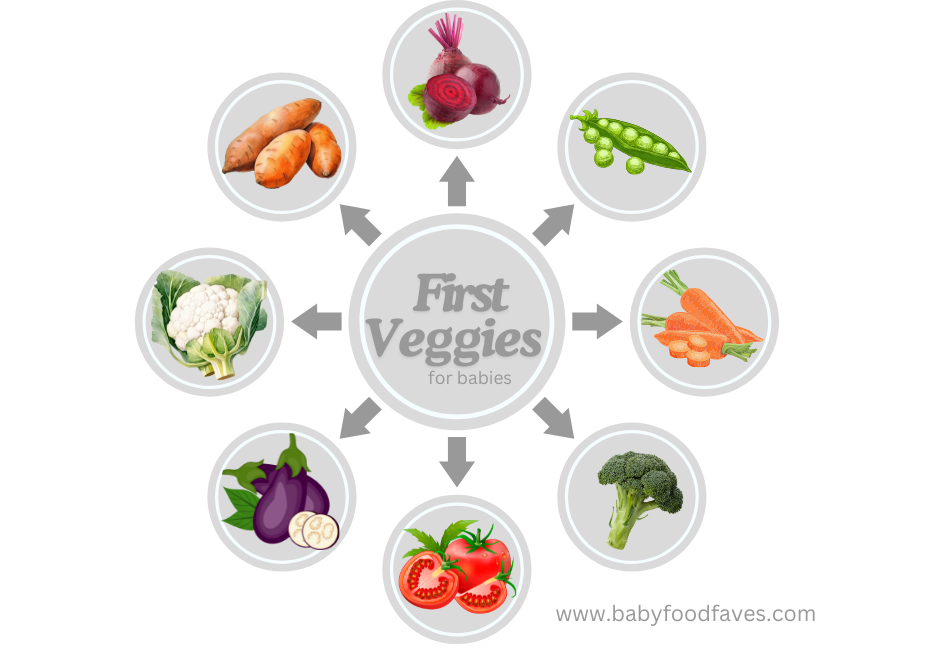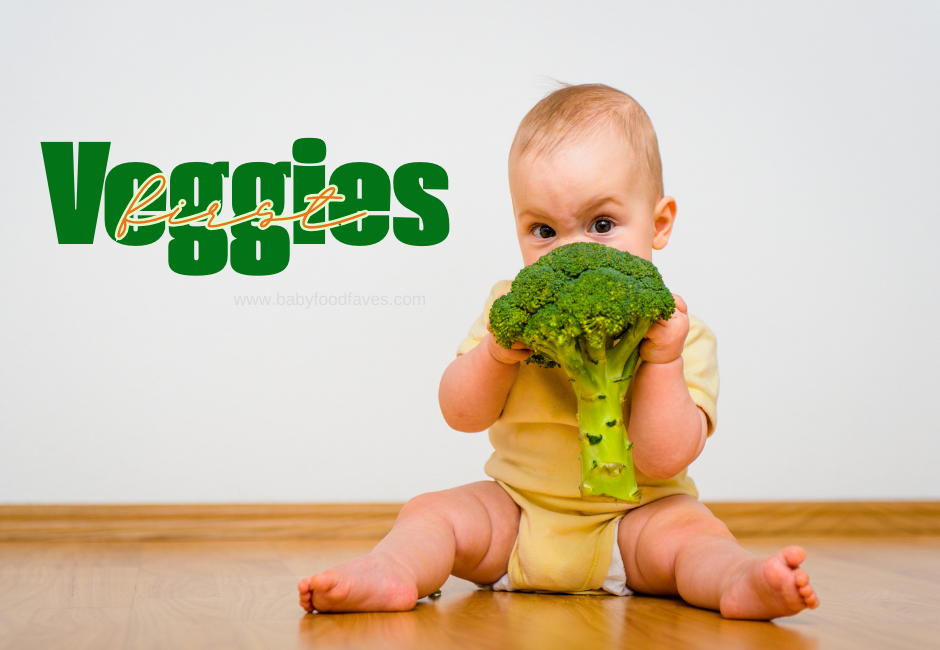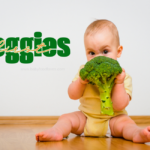The Colorful World of First Vegetables for Your Baby
We all aim to make the right choices for our baby’s health and development, which probably brought you here, seeking advice on introducing vegetables for babies. You’re looking for reliable information to help you make the right choices when adding new foods to your little one’s diet.
I’m sure you’ve often heard timeless advice emphasizing the importance of consuming plenty of fruits and vegetables for overall health. While introducing fruits into your baby’s diet is relatively straightforward (I have a whole article dedicated to introducing fruits to your Baby here!), vegetables can present a unique challenge. Unlike fruits, which offer natural sweetness, vegetables may not immediately captivate babies’ taste buds. However, they have essential nutrients like calcium, folate, and iron, which are crucial for your baby’s growth and development.
As parents, we play a significant role in teaching our babies good habits, like eating veggies for example. That’s why it’s essential to start and present the food in a way that makes it hard for your little one to resist. This article is all about the best first vegetables for babies. We’ll explore the vegetables list to kickstart this journey, explaining why they make excellent choices for introducing solids. Additionally, I’ll provide practical tips on how to prepare and serve these veggies according to your baby’s age.
Table of Contents
- The Colorful World of First Vegetables for Your Baby
- Starting Solids with Vegetables Sets the Stage for Healthy Eating Habits. When, How and Why?
- Top 12 First Vegetables for Babies
- Vegetables that require extra caution
- Creative vegetable puree ideas that will delight your Baby’s TasteBuds
- FAQ About Introducing first vegetables to babies
Starting Solids with Vegetables Sets the Stage for Healthy Eating Habits. When, How and Why?
When?
Most babies are developmentally prepared to begin solid foods between 4 and 6 months old. However, It’s important to observe your baby for signs of readiness during this period; I have a comprehensive article about this stage, check it out. The American Academy of Pediatrics suggests waiting until approximately 6 months to ensure optimal readiness. Since every baby progresses at their unique pace, consulting your pediatrician before introducing solids, especially if considering starting before 6 months, is crucial. They can evaluate your baby’s specific development and offer personalized guidance.
How?
I consider that vegetables are a fantastic first food for babies! They provide vital vitamins, minerals, and fiber, promoting healthy growth and development. But, not all vegetables are alike when introducing them to babies. For a seamless transition, it’s advisable to start solids with vegetables that are easy to digest and less likely to cause allergies.
Generally, vegetables are safe for babies when introduced in puree form or when they are well-cooked. However, if you opt for the baby-led weaning program, where whole foods are introduced to your child, it’s essential to avoid serving raw, hard vegetables like carrots or stringy ones like celery, as they pose choking hazards.
Remember, it’s important to be patient even if your baby doesn’t seem to like vegetables at first. Tastes can change over time, so continue to offer veggies regularly—it may take a few attempts before your baby learns to enjoy them.
Why?
In my opinion, starting with fruits or grains might make it harder for your baby to enjoy vegetables later, as they may come to expect sweetness in every meal. Babies don’t have a strong preference for sweet tastes at first, so vegetables will naturally taste good to them. Introducing a variety of vegetables early on gives your little one the best chance to develop a love for them. However, if you prefer, starting with fruits is perfectly fine. Every baby is different, and you’ll soon learn their unique tastes. If your baby refuses vegetables, try mixing them with fruits or start with naturally sweet options like sweet potatoes or carrots.
Top 12 First Vegetables for Babies

Best Vegetables for Babies 4-6 months
The ideal first vegetables for babies aged 4-6 months are gentle in taste, soft in texture, and unlikely to cause allergic reactions. If you’re uncertain about what vegetables to introduce to baby first, below are the top choices for introducing your baby to solid foods.
- Sweet Potatoes
Benefits: Sweet potatoes are an excellent first food due to their smooth texture and natural sweetness. They are loaded with vitamin A, vitamin C, fiber, and potassium, which are important for a strong immune system, eye health, and skin health.
Texture: Steam and mash or puree sweet potatoes. For a smoother consistency, add breast milk or formula.
Parent Tip: Ensure the sweet potatoes are soft, well-cooked, and cooled before serving. For babies aged 4-6 months, make sure to mash them thoroughly and remove the skin.
- Carrots
Benefits: Carrots are another excellent choice to introduce to your baby due to their natural sweetness and high nutrient content. They are rich in beta-carotene, which the body converts into vitamin A. This nutrient is essential for your baby’s eyesight, skin, and overall growth.
Texture: Carrots can be steamed until soft and then mashed or pureed. Remember to keep the consistency thin initially.
Parent Tip: Peel the carrots before cooking to remove any potential contaminants. Once cooked, you can freeze individual portions of carrot puree in an ice cube tray for later use.
- Butternut Squash
Benefits: Like sweet potato, butternut squash offers a naturally sweet flavor and is a good source of vitamin A, C, potassium and fiber. These nutrients help support healthy vision, immune function, and digestion.
Texture: Roast, steam, or boil butternut squash until very soft, then mash or puree it. For a smoother consistency, add a little breast milk or formula.
Parent Tip: Roasting brings out a natural sweetness that babies often enjoy.
Other good vegetables for babies at this stage include zucchini, beetroot, pumpkin and many more. Ensure they are well-cooked and have a smooth consistency that your baby can easily handle.
Keep in mind:
Introducing vegetables to your baby at an early stage can help them develop a taste for these nutritious foods. Sweet potatoes, carrots and pumpkin are all excellent baby veggies that are packed with vital nutrients and easy to digest. Remember to introduce each vegetable individually. Offer the same vegetable to your baby for at least three consecutive days before introducing another. This approach helps identify any potential allergies. Once you’ve established their tolerance, feel free to mix and create various recipes for your baby. As always, consult with your pediatrician before starting any new food. With the right approach, your baby’s transition to solids can be a smooth and enjoyable journey.
Best Veggies for Toddlers 7-8 months
At this age, you can continue offering the vegetables your child has tried as purees, but now prepare them differently. Provide small bites instead of purees so they can explore various flavors and textures. You can also start mixing two or more vegetables for added taste.
- Cauliflower
Benefits: Cauliflower is a great superfood because it contains vitamins C and K, folate, and fiber. It is also one of the few vegetables that contain choline, a nutrient that supports cell health, the nervous system, the heart, and the liver.
Texture: Cauliflower is soft and easily mashable. Steam or boil it until very tender, then mash it with a fork or puree it. It should be smooth enough for your baby to handle but can have a bit more texture compared to the initial introduction phase.
Parent Tip: To balance the taste, introduce cauliflower with other mild-flavored vegetables, like potatoes or carrots.
- Broccoli
Benefits: Broccoli is a nutritional powerhouse for 6-8-month-old toddlers and everyone else. It’s abundant in essential micronutrients like beta-carotene, folic acid, potassium, and vitamins C, K, and A, bolsters immune function, promotes bone health, and supports vision. Moreover, broccoli is a good source of fiber, facilitating digestion and iron, which are vital for healthy blood development. Additionally, as a cruciferous vegetable, broccoli offers cancer-fighting properties.
Texture: For 6-8-month-old toddlers, broccoli should be soft enough for easy chewing and swallowing but still have some texture to encourage oral motor development. You can also steam broccoli until it is soft enough to be easily squished between your fingers, allowing your toddler to practice their pincer grasp.
Parent Tip: You can also mix mashed broccoli with foods such as mashed sweet potatoes or brown rice to introduce new flavors and textures. Additionally, try to serve broccoli in different forms, such as roasted or steamed, to expose your toddler to a variety of tastes and textures.
- Beetroot
Benefits: Beetroot offers a wealth of benefits for toddlers. Rich in nutrients like folate, manganese, and vitamin C, it supports healthy growth and development. Additionally, beetroot contains dietary fiber, aiding digestion, and nitrates which may promote improved blood flow and lower blood pressure.
Texture: For toddlers, beetroot should be cooked until exceptionally tender and then mashed or pureed to achieve a smooth consistency. It should be soft for easy chewing and swallowing, yet with some texture to encourage oral motor development. Alternatively, you can steam beetroot until it’s easily squished between your fingers, allowing your toddler to practice their pincer grasp.
Parent Tip: Begin with small portions to gauge your toddler’s acceptance, as its earthy flavor may pose a challenge for some children. Consider blending it with complementary foods such as applesauce to diversify tastes and textures.
Other veggies you can introduce at this stage: Bell peppers, zucchini, spinach, peas etc. Remove any seeds and stringy bits.
Best Veggies for Toddlers 9-12 months. Baby-Led Weaning
As your baby reaches the 8-10 month mark, their dietary journey becomes more exciting. At this age, babies can start developing their finger food skills, which is crucial for their motor development and independence during meal times. To facilitate this, babies’ vegetables should be peeled and cut into sticks, making them easy to grasp and chew. Below are some tips and guidelines to help you navigate this stage and make the most out of introducing new vegetables to your little one’s diet.
- Cucumber
Benefits: Cucumbers are low in calories and high in water content, helping to keep your toddler hydrated and promoting healthy digestion. Cucumbers also contain vitamins K and C and minerals like potassium, which support bone health and immune function.
Texture: For toddlers aged 8-12 months, cucumber should be peeled and diced into small, soft pieces or cut into thin, easy-to-chew slices. The texture should be soft enough for your toddler to mash with their gums but still provide some resistance for chewing practice. Avoid serving large chunks that could pose a choking hazard.
Parent Tip: Make eating cucumber more enjoyable for your toddler by cutting it into fun shapes or arranging it in colorful patterns on their plate. This can make mealtime more engaging and encourage them to try new foods.
- Eggplant
Benefits: Eggplant is low in calories and rich in dietary fiber, promoting healthy digestion and regular bowel movements. Eggplant also contains vitamins and minerals such as vitamins C and K, potassium, and manganese, which support overall health and development.
Texture: Eggplant should be cooked until very soft and then mashed or diced into small, easy-to-chew pieces. The texture should be soft enough for your toddler to easily mash with their gums but still provide some texture for chewing practice.
Parent Tip: When preparing eggplant for your toddler, consider roasting or steaming it until it’s very tender to make it easier to digest and chew. Avoid serving large chunks that could pose a choking hazard.
- Tomatoes
Benefits: Tomatoes contain antioxidants like lycopene, which helps protect cells from damage and supports overall health. They can be incorporated into various dishes, making it easy to add them to your toddler’s diet in a fun and appealing way.
Texture: As your child becomes better at chewing, you can start offering certain raw vegetables like thinly sliced cherry tomatoes (cut into small pieces to prevent choking).
Parent Tip: Involve Them in Cooking. Let your toddler help with simple tasks like washing vegetables or stirring. This can make them more interested in eating what they’ve helped prepare.
- Peas
Benefits: Peas are small but mighty. They are loaded with vitamins A and C, iron, protein, and dietary fiber. They are also naturally sweet, making them more appealing to babies.
Texture: You can cook, mash, or blend peas into a puree.
Parent Tip: To ensure easier digestion, you can strain the puree to remove the skin.
Best Vegetables for babies 1-year-old and Up
As your baby reaches the age of 12 months and beyond, their dietary needs and capabilities continue to evolve. At this stage, they are more proficient with chewing and handling a variety of textures, making mealtime even more exciting. Continue to offer vegetables as finger foods to encourage self-feeding and fine motor skills. These can include steamed or roasted vegetable sticks, small cubes, or even whole peas and corn kernels.
- Brussels sprouts
Benefits: Brussels sprouts are a nutrient-dense vegetable, providing a high amount of vitamins C and K. Vitamin C is essential for a strong immune system and skin health, while vitamin K plays a crucial role in blood clotting and bone health.
Texture: When roasted or steamed, Brussels sprouts become soft and easier for babies to chew and digest. The texture should be tender, not mushy, to ensure it’s pleasant for your baby to eat.
Tip: You can also mix them with other pureed or finely chopped vegetables to introduce a variety of flavors and textures.
- Green Salad
Benefits: Baby green vegetables and salads are rich in vitamins A, C, and K, as well as folate, potassium, and fiber. Vitamin A promotes healthy vision and immune function, vitamin C supports the immune system and collagen production, and vitamin K is essential for blood clotting and bone health. Folate is important for cell growth and development, while potassium helps regulate blood pressure and heart function. Additionally, the fiber in green salads aids in digestion and promotes a healthy gut microbiome.
Texture: To ensure the salad is suitable for babies, you can finely chop or shred the greens to reduce the risk of choking.
Tip: When preparing a green salad for your baby, choose fresh, organic greens and wash them thoroughly to remove any dirt or pesticides. Avoid adding dressings or toppings that may be too spicy or contain added sugars or salt. Instead, you can lightly toss the greens with a small amount of olive oil or mashed avocado for added flavor and healthy fats. Serve the salad in small, manageable portions, and always supervise your baby while they are eating to prevent choking.
As your toddler continues to grow and explore new flavors, introducing a variety of vegetables into their diet becomes increasingly important. Aim for a rainbow of good vegetables to ensure a broad spectrum of nutrients. Each color often represents different vitamins and minerals, providing a diverse array of health benefits. By offering a colorful assortment of vegetables, you can help support your toddler’s overall health and development. Remember to continue offering vegetables to your baby in different forms and combinations to encourage adventurous eating habits and foster a love for nutritious foods that will last a lifetime.
Vegetables that require extra caution
When introducing a baby’s first vegetables, it’s important to avoid raw and hard varieties to minimize the risk of choking. Certain vegetables pose a higher risk than others due to their texture, size, and shape, which could potentially obstruct a young child’s airway. These include:
- Raw, hard veggies
- Vegetables that are difficult to chew
- Vegetables with shapes or sizes that may block the airway
- Vegetables with smooth yet sticky textures or unpeeled skins
The vegetables that present a choking risk and require extra caution include:
- Raw Carrots
- Celery
- Raw broccoli
- Raw cauliflower
- Whole cherry or grapes
- Whole peas
- Whole green beans (uncooked)
- Radishes
- Corn
- Whole olives
Prioritize cooking or preparing these vegetables to ensure they are soft and safe for your little one to enjoy.
Creative vegetable puree ideas that will delight your Baby’s TasteBuds
Vegetable Purees:
- Sweet Potato Puree
- Carrot Puree
- Pumpkin Puree
- Butternut Squash Puree
- Pea Puree
- Green Bean Puree
- Zucchini Puree
- Spinach Puree
- Broccoli Puree
- Cauliflower Puree
Mixed Vegetable Purees:
- Mixed Vegetable Medley (carrots, peas, and sweet potatoes)
- Veggie Mash (carrots, potatoes, and peas)
- Ratatouille (eggplant, zucchini, bell peppers, and tomatoes)
- Vegetable Soup (carrots, celery, onions, and potatoes)
- Veggie Risotto (carrots, peas, spinach, and mushrooms)
- Vegetable Stir-fry (bell peppers, broccoli, snap peas, and carrots)
- Veggie Pasta Sauce (tomatoes, carrots, onions, and bell peppers)
- Veggie Curry (potatoes, cauliflower, peas, and spinach)
- Vegetable Omelette (spinach, tomatoes, bell peppers, and mushrooms)
- Vegetable Casserole (squash, zucchini, onions, and tomatoes)
These purees and mixed dishes offer a variety of flavors and nutrients to support your baby’s healthy growth and development. Remember to gradually introduce new vegetables and observe any signs of allergies or sensitivities.
FAQ About Introducing first vegetables to babies
Q: What are the best vegetables to start with? A: Opt for soft, mild-flavored vegetables that are unlikely to cause allergic reactions, such as sweet potatoes, carrots, and butternut squash. These vegetables are easy to digest and packed with essential nutrients for your baby’s growth and development.
Q: How should I prepare vegetables for my baby? A: First vegetables can be steamed, boiled, or roasted until they are soft and then mashed or pureed to a smooth consistency. Make sure to remove any seeds, skins, or tough fibers that could pose a choking hazard. You can also mix vegetables with breast milk or formula for added nutrition and to adjust the texture.
Q: How do I know if my baby is allergic to a particular vegetable? A: Introduce one new vegetable at a time and wait for at least three days before introducing another. This approach allows you to monitor your baby for any signs of an allergic reaction, such as rash, hives, vomiting, or diarrhea. If you suspect an allergy, stop feeding the vegetable and consult your pediatrician.
Q: What if my baby refuses to eat vegetables? A: It’s normal for babies to be hesitant about trying new foods, including vegetables. Be patient and continue offering vegetables regularly, even if your baby initially rejects them. You can try different cooking methods, textures, and flavor combinations to make vegetables more appealing to your baby.
Q: Can I give my baby store-bought baby food instead of homemade purees? A: While store-bought baby food can be convenient, homemade purees allow you to control the ingredients and quality of the food. If you choose to use store-bought baby food, opt for varieties with minimal added sugars, salt, and preservatives, and always check the expiration date





